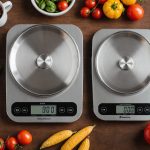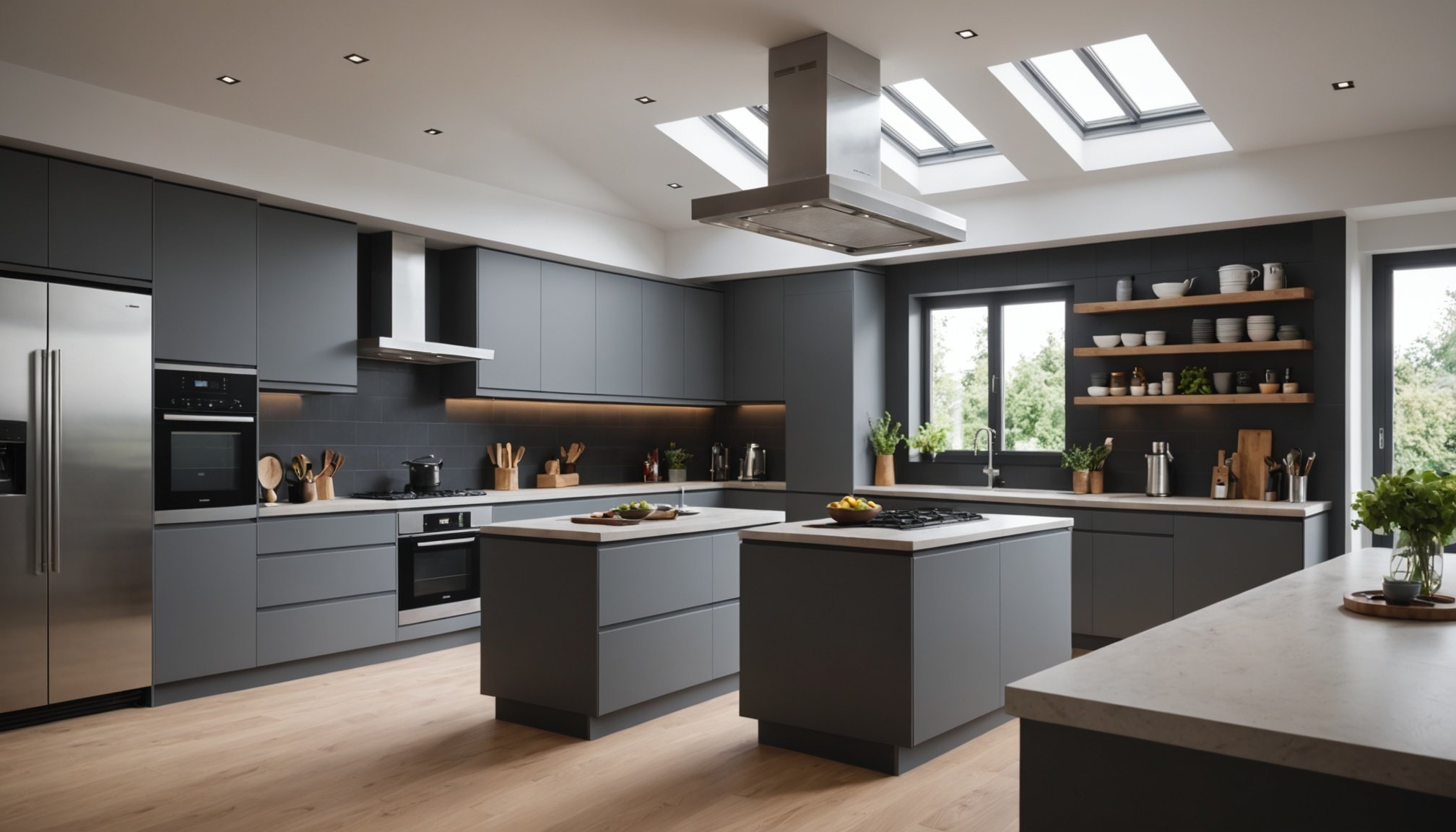Understanding Kitchen Ventilation Systems
Kitchen ventilation systems are essential for maintaining a healthy cooking environment by removing smoke, odours, and excess humidity. They play a crucial role in ensuring good air quality and preventing grease buildup on surfaces.
Types of Kitchen Ventilation Systems
In the UK, there are several types of kitchen ventilation systems available, each catering to different needs:
This might interest you : Ultimate guide to choosing the ideal refrigerator size for your expanding family in the uk
-
Extractor Hoods: These are the most common, installed directly over a hob or stove to capture smoke and steam.
-
Recirculating Hoods: Suitable for installations where external venting isn’t possible, they filter air through charcoal before recirculating it back into the kitchen.
This might interest you : Essential handbook for selecting the best compostable kitchen bags in the uk
-
Downdraft Systems: Typically integrated into kitchen islands, these pull air downward through vents located behind or beside the hob.
Benefits of Installing an Efficient Ventilation System
An efficient kitchen ventilation system offers numerous benefits:
-
It significantly improves indoor air quality by eliminating airborne pollutants.
-
Helps prevent the growth of mold by controlling moisture levels.
-
Reduces the risk of kitchen fires, particularly in homes with gas stoves, by removing flammable grease particles.
By selecting the right type of kitchen ventilation system, homeowners can create a cleaner, safer, and more pleasant cooking environment.
Planning Your Kitchen Ventilation Installation
When planning your kitchen ventilation installation, understanding your home layout and specific ventilation needs is crucial. Start by assessing the size of your kitchen and your cooking habits. For instance, if you frequently cook with heavy spices or use gas stoves, a more robust system might be necessary. The placement of windows and doors also impacts air circulation and should be taken into consideration.
Factors to consider include the size of your kitchen, as larger kitchens might require more powerful ventilation systems. Cooking habits play a role too; frequent frying or steaming demands better ventilation to manage smoke and moisture effectively.
Determining your budget and setting a timeline for the installation is essential. Costs can vary depending on the complexity of the system and whether professional services are needed. A realistic timeline helps in coordinating the installation process and ensures everything is done methodically.
Additionally, consider home layout influences such as open-plan designs that might affect airflow, necessitating a more strategic placement or system type. Carefully planning these aspects will ensure that your kitchen remains a pleasant and safe environment when cooking.
Step-by-Step Installation Guide
Considering a professional installation of a kitchen ventilation system involves a series of organized steps that ensure efficiency and safety.
Preparing the Space
Begin by evaluating your kitchen space. Measure the area intended for the ventilation system to ensure a proper fit. This step is crucial for accommodating all system components without hindering kitchen functionality. Clearing the workspace of obstructions and securing additional tools ensures an uninterrupted installation process, setting the stage for a seamless setup.
Installing the Ventilation System
Following the preparation, mounting the system requires precision. Align the ventilation system according to the manufacturer’s guidelines. Securing brackets and supports ensures stability, while connecting necessary ducts and filters facilitates effective ventilation. For extractor hoods, ensuring alignment over the hob maximizes smoke and steam capture. Pay attention to wiring, ensuring safe connections to power sources.
Finalizing the Setup
Complete the installation process by conducting a thorough inspection to confirm functionality. Check that all components are securely fastened, and test the system to ensure proper air extraction or recirculation. Adjust settings as needed for optimal performance. A final walkthrough by a professional installer verifies safety compliance and operational efficiency, delivering peace of mind and a well-ventilated kitchen space.
Recommended Products for UK Homes
Identifying the right kitchen ventilation products is crucial for achieving an optimal cooking environment. In the UK, some top-rated systems that homeowners frequently consider include extractor hoods, recirculating hoods, and downdraft systems.
Product Comparison
When comparing features, it’s essential to look at the energy efficiency of each unit. Modern extractor hoods often come equipped with energy-efficient LED lighting and variable speed settings, making them both economical and environmentally friendly. Recirculating hoods, meanwhile, are valued for their easy installation and effective air purifying capabilities through charcoal filters.
Recommendations
Several brands are frequently recommended due to their reliable performance and durability. Brands like Bosch, Neff, and Siemens offer competitive pricing along with robust features. For those prioritising silent operation, consider models specifically designed with noise reduction technologies.
Sourcing Products
Knowing where to buy your ventilation systems is equally important. Look for established retailers that offer product reviews and warranties to back their systems. Consider sourcing from reputable companies like John Lewis, Currys, or specialty kitchen retailers. This provides confidence in the product’s authenticity and support services. Through careful comparison and sourcing, UK homeowners can ensure they choose the best products to enhance their kitchen environments.
Local Regulations and Safety Considerations
Ensuring compliance with local regulations and upholding safety standards is pivotal in kitchen ventilation installations. The UK mandates specific guidelines that must be adhered to, guaranteeing that systems not only perform efficiently but also safely.
Overview of Regulations
Regulatory compliance involves adhering to building codes focused on ventilation system requirements. It’s essential to install systems that meet the minimum standards set for air change rates and noise levels. Understanding these requirements helps prevent future complications and ensures systems are legally operable.
Safety Standards and Best Practices
Adhering to safety standards minimizes risks like fire hazards and air quality issues. For gas stoves, this includes installing ventilation that effectively removes flammable gases. Additionally, ensuring electrical connections meet safety codes is non-negotiable, preventing shock or fire risks.
Importance of Certified Professionals
Engaging certified professionals is critical for ensuring both compliance and safety. Professionals possess the expertise to navigate regulations and perform installations accurately. Their knowledge extends to efficiently handling electrical connections and optimizing system placement, thereby safeguarding your home. Opting for certified technicians guarantees that the installation not only meets but exceeds regulatory and safety expectations.
Maintenance Tips for Longevity
Ensuring the longevity of your kitchen ventilation systems requires a consistent maintenance routine. Regular cleaning is crucial to prevent grease buildup and maintain airflow efficiency. Clean the filters periodically, as clogged filters hinder performance and can pose fire hazards. For stainless steel surfaces, gentle cleaning solutions and a soft cloth are recommended to avoid scratches and maintain the unit’s appearance.
Troubleshooting common issues early can prevent extensive repairs and prolong the system’s life. If you notice unusual noises or diminished airflow, check for loose connections or obstructions. Replacing worn-out components promptly is key to avoiding larger problems. Ensure that fan blades are not obstructed and are spinning freely to maintain optimal efficiency.
Routine inspections by professionals can identify potential issues before they escalate. Annual servicing ensures all components function correctly and that the system complies with current safety standards. Technicians can also provide personalized advice for maintaining specific brands or models. Making these efforts consistently will keep your kitchen ventilation system running smoothly and efficiently, ultimately providing a healthier and more pleasant cooking environment.
Energy Efficiency and Environmental Impact
Energy-efficient ventilation systems offer a host of benefits, making them a practical choice for environmentally conscious homeowners. Installing such systems can significantly lower utility bills, providing economic relief over time. They utilise modern technologies like LED lighting and variable speed settings. These features not only cut down on energy consumption but also prolong the lifespan of the system, contributing to its overall cost-effectiveness.
Environmental advantages cannot be overstated. By reducing energy consumption, efficient ventilation systems decrease carbon emissions, helping to mitigate climate change. It’s worth investing in systems with high energy ratings, such as those labelled with class A or above in the UK Energy Label. These labels indicate compliance with environmental and efficiency standards.
Choosing eco-friendly options is simpler than ever. Look for systems with sustainable materials that are designed for low environmental impact during both production and disposal.
To enhance energy efficiency, ensure the system is regularly maintained, including cleaning filters and checking components. This practice ensures optimal performance and minimises unnecessary energy use. Adopting sustainable approaches in kitchen ventilation not only serves individual households but also contributes positively to the broader environmental goals.
Frequently Asked Questions (FAQs)
Understanding kitchen ventilation systems can be complex, and common inquiries often arise. To help, we’ve addressed the most frequent questions, ensuring clarity for users navigating these essential components.
Q: What are the main types of kitchen ventilation systems available for UK homes?
A: In the UK, the predominant types include extractor hoods, recirculating hoods, and downdraft systems. Extractor hoods are installed over hobs, capturing smoke and steam efficiently. Recirculating hoods are ideal when external venting isn’t feasible, using charcoal filters to clean air before returning it indoors. Downdraft systems, often part of kitchen islands, direct air downward through specific vents.
Q: What are the major benefits of a well-installed kitchen ventilation system?
A: Benefits encompass improved air quality by eliminating pollutants, moisture control to prevent mould, and reduced fire risk by removing grease particles, especially in homes with gas stoves.
Q: How do I troubleshoot a ventilation system that isn’t functioning properly?
A: Start by checking for blocked filters, inspecting fan obstructions, and ensuring all electrical connections are intact. Regular maintenance and professional inspections can preempt larger issues.
Visual Aids and Resources
Utilising visual aids is paramount when it comes to understanding the intricacies of kitchen ventilation system installation. Such aids can transform complex instructions into digestible information, making them indispensable for both homeowners and professionals.
Recommended Resources
When attempting a DIY installation, turning to detailed installation diagrams can offer clarity and assurance. These diagrams typically illustrate component layout and subsystem connections, crucial for avoiding common installation pitfalls.
For those relying on online platforms, instructional videos provide step-by-step guides showcasing proper installation techniques and troubleshooting basics. Websites focusing on home improvement often host these valuable resources.
Consider also exploring online guides available through professional service websites, which frequently feature expert tips tailored to specific systems and brands. These guides sometimes include checklists that can be printed and used during the installation process.
Sample Diagrams in Use
Sample diagrams generally depict typical ventilation setups found in UK homes. They may include various options such as extractor hoods placed over stoves or downdraft systems incorporated into kitchen islands. With these aids, users gain not only a visual understanding but also the confidence to execute installations correctly and efficiently.











